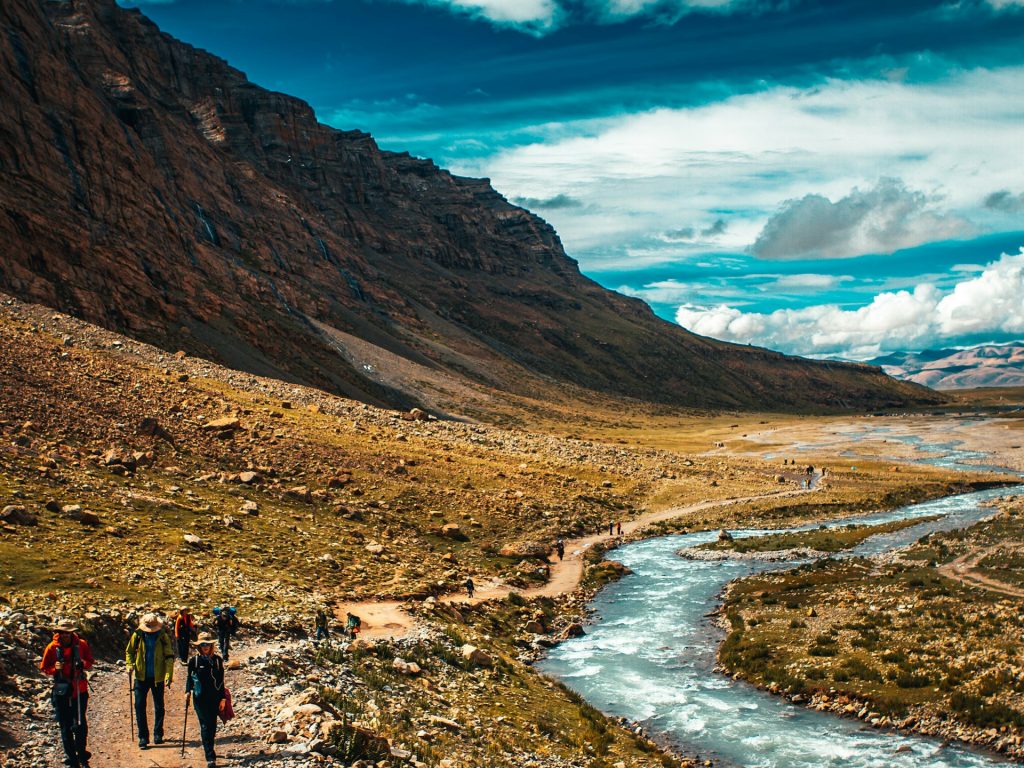The Kailash Mansarovar Tour is one of the most revered pilgrimages in the world, drawing devotees from Hinduism, Buddhism, Jainism, and Bon.

This sacred journey, nestled in the remote reaches of Tibet, takes pilgrims to the foot of Mount Kailash (6,638 meters / 21,778 feet) and the serene Lake Mansarovar, both of which hold immense religious significance.
The journey is not only a test of physical endurance but also an intense spiritual experience, as pilgrims engage in various religious activities throughout the trip. Each activity is imbued with deep meaning, reflecting the spiritual essence of the pilgrimage.
1. Circumambulation (Kora) of Mount Kailash
The central religious activity during the Kailash Mansarovar tour is the Kora, a circumambulation or parikrama around Mount Kailash.
For Hindus, Buddhists, and Jains, walking around the mountain is an act of deep devotion, believed to cleanse one’s sins and bring about spiritual enlightenment.
The Kora is a challenging 52-kilometer (32-mile) trek, often completed in three days, with the most sacred point being the Dolma La Pass, which rises to 5,636 meters (18,500 feet).
Buddhists and Bon followers complete the Kora in a clockwise direction, while Bon practitioners walk counterclockwise. The journey symbolizes the cycle of life, death, and rebirth, offering spiritual renewal and divine blessings.
In Hinduism, Mount Kailash is considered the earthly manifestation of Mount Meru, the spiritual center of the universe and the abode of Lord Shiva.
Completing one Kora is said to free a person from the cycle of rebirth, while 108 circumambulations are believed to guarantee enlightenment.
Buddhists believe that walking around Mount Kailash purifies one’s karma, and Bon traditions view the mountain as the axis of the world.
Given the high altitude and rough terrain, pilgrims should be physically prepared for the trek. It is crucial to acclimatize properly to avoid altitude sickness and to pack warm clothing, as temperatures can drop significantly, especially at higher altitudes.
2. Holy Dip in Lake Mansarovar
Taking a holy dip in Lake Mansarovar is one of the most important religious activities during the pilgrimage. This pristine freshwater lake, located at an elevation of 4,590 meters (15,060 feet), is considered the highest freshwater lake in the world.
Hindus believe that a bath in Lake Mansarovar washes away the sins of a lifetime and purifies the soul. The waters of Mansarovar are also believed to have healing properties, making the act of bathing both a physical and spiritual purification ritual. Pilgrims often collect the sacred water to take home as a blessing for their families.
According to Hindu mythology, Lake Mansarovar was created by Lord Brahma, the creator of the universe. It is believed to be the resting place of the gods and a source of spiritual power.
For Buddhists, the lake is linked to Anavatapta, the dragon king who resides in the lake and brings peace to the world.
The water in Lake Mansarovar is freezing, so pilgrims are advised to take short dips to avoid hypothermia. It’s also important to respect local customs and traditions when performing religious rites at the lake.
3. Offering Prayers and Rituals at Ashtapad
Ashtapad, located at the base of Mount Kailash, is an important pilgrimage site, particularly for Jains. This location is believed to be where Rishabhadeva, the first Tirthankara of Jainism, attained enlightenment.
Pilgrims visit Ashtapad to offer prayers and pay their respects to the sacred site. For Hindus and Buddhists, Ashtapad also holds significance as it is considered a gateway to heaven, symbolizing spiritual ascension. Offering prayers here is believed to bring inner peace and divine blessings.
Ashtapad is significant in Jain cosmology as it marks the site of Rishabhadeva’s moksha (liberation). For Hindus, the place holds mythological importance as the base of the spiritual Mount Meru.
Ashtapad is located at a high altitude, and reaching it requires physical fitness. Pilgrims are advised to move slowly and avoid overexertion due to the lack of oxygen at this height.
4. Performing Puja and Meditation at Gauri Kund
Gauri Kund, also known as the “Lake of Compassion,” is a sacred lake located on the route of the Kailash Kora, just before reaching Dolma La Pass. This emerald-green lake holds great significance for Hindu pilgrims, as it is associated with the goddess Parvati, the consort of Lord Shiva.
Pilgrims stop here to perform puja (worship), offer flowers and prayers, and meditate by the lake’s edge. The peaceful surroundings make it an ideal place for spiritual contemplation.
According to Hindu mythology, Gauri Kund is where Goddess Parvati created her son, Lord Ganesha, from the clay of the earth and breathed life into him. This sacred site is believed to be a place of divine creation and renewal.
The path to Gauri Kund can be steep and slippery, especially during wet or icy conditions. Pilgrims should tread carefully and carry necessary supplies such as walking sticks for support.
5. Lighting Butter Lamps at Monasteries
Along the route of the Kailash Mansarovar tour, there are several Tibetan Buddhist monasteries where pilgrims stop to light butter lamps and offer prayers. Lighting a butter lamp is a traditional act of devotion, symbolizing the dispelling of ignorance and the illumination of the path to enlightenment.
Pilgrims often stop at Chiu Monastery, perched on a hill near Lake Mansarovar, or at Dirapuk Monastery, located along the Kora trail, to perform this ritual. These monasteries offer a moment of spiritual reflection and a chance to connect with the Buddhist traditions of the region.
For Buddhists, lighting butter lamps represents wisdom and clarity of mind. The act of offering light symbolizes a wish for all beings to be free from the darkness of ignorance and to achieve spiritual awakening.
Monasteries are places of quiet contemplation, and pilgrims should be respectful, avoid loud conversations, and follow the guidelines provided by the monks.
6. Offering Food and Prayers to the Local Deities
In Tibetan Bon tradition, the Kailash region is home to local deities and spirits who protect the land and its people. During the pilgrimage, some travelers take part in the ritual of offering Tsampa (barley flour), butter, and tea to these deities as a way of seeking protection and blessings for the journey.
This ancient practice honors the guardians of the land and expresses gratitude for safe passage through the mountains. While this activity is more closely tied to Bon traditions, many pilgrims from other faiths participate as a sign of respect for the local culture and beliefs.
Bon, the indigenous religion of Tibet, views Mount Kailash as the axis of the world, with deities inhabiting its surrounding peaks. Offering food and prayers is a way to show reverence and seek the favor of these protective forces.
It is important to perform these offerings with reverence and sincerity, following the guidance of local spiritual leaders or monks.
Conclusion
The Kailash Mansarovar Tour is not just a physical journey but a deeply spiritual one, offering pilgrims the opportunity to engage in meaningful religious activities that bring them closer to the divine.
Whether it’s the profound experience of completing the Kailash Kora, the sacred act of bathing in Lake Mansarovar, or the peaceful moments of meditation at Gauri Kund, each activity carries immense religious importance.
These practices, passed down through centuries of devotion, continue to inspire and transform the lives of those who undertake this sacred pilgrimage.
